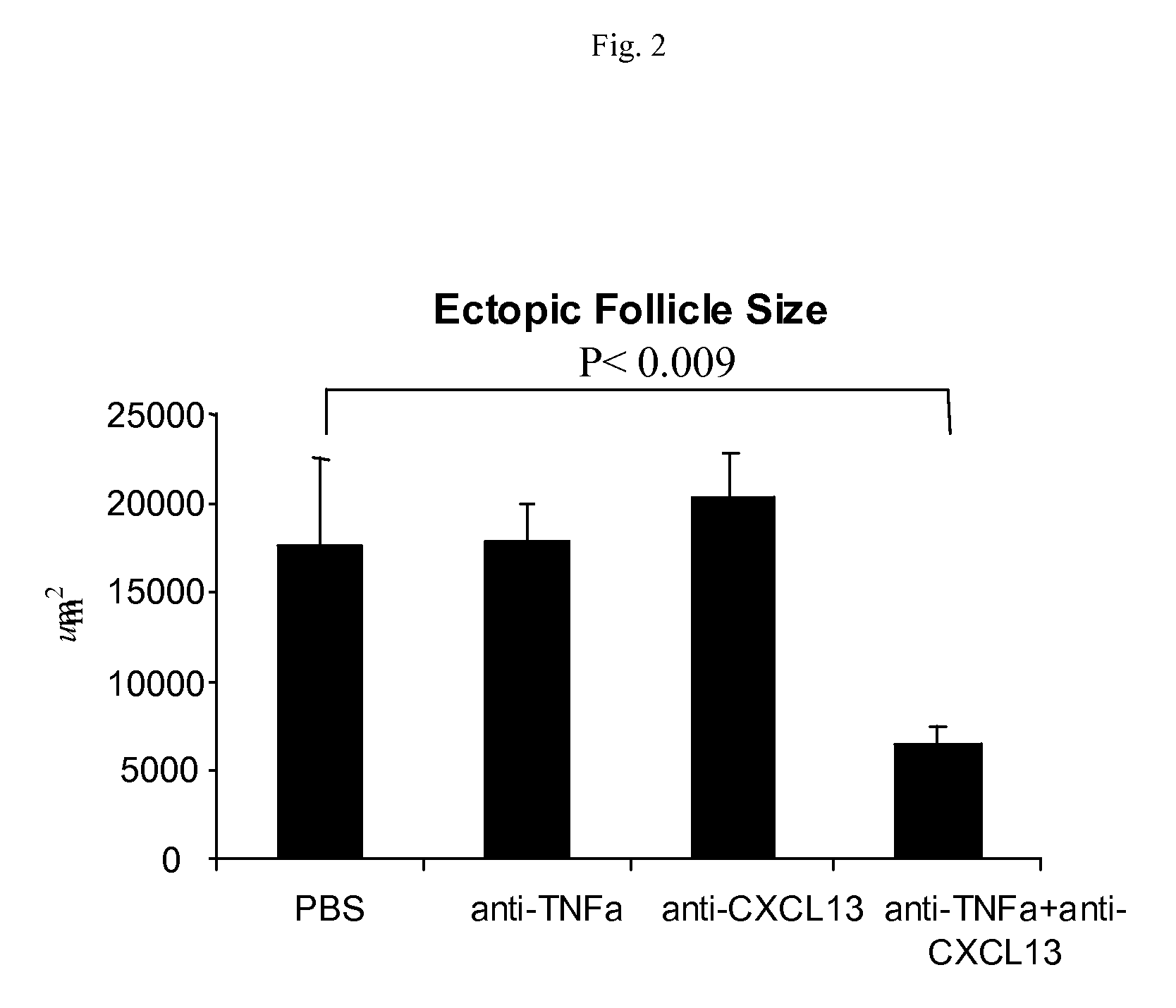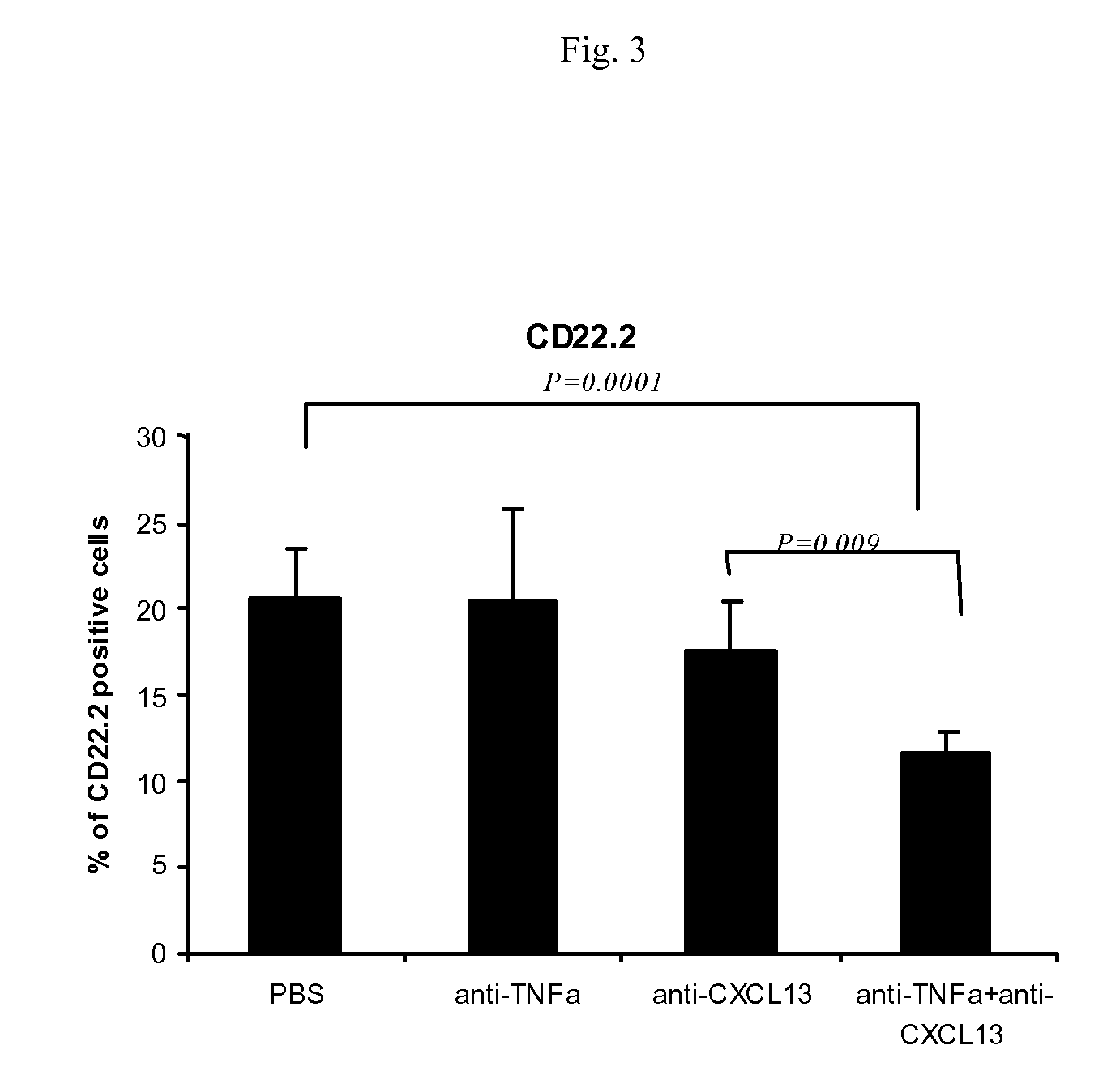CXCL13 antagonists and their use for the treatment of inflammatory diseases
a technology of cxcl13 and antagonists, which is applied in the field of cxcl13 antagonists, can solve the problems of inflammation and tissue damage, harm to the liver, kidneys and nervous system, and affect the immune system,
- Summary
- Abstract
- Description
- Claims
- Application Information
AI Technical Summary
Benefits of technology
Problems solved by technology
Method used
Image
Examples
example 1
CXCL13 mRNA Transcript Levels are Elevated in Diseased Lung Tissues
[0174]The levels of mRNA transcripts encoding the CXCL13 protein are elevated in the lung tissue of untreated SP-C / TNFα mice, and SP-C / TNFα mice treated with a TNFα specific mAb relative to control C57BL6 mice (FIG. 1). SP-C / TNF-alpha mice are transgenic mice derived from the C57BL6 mouse strain that constituatively over-express murine TNFα in the lung tissues Over expression of TNFα in the lung (SP-C / TNFα transgenic mice) causes many pathological changes similar to those found in COPD patients, including pulmonary inflammation, emphysema, pulmonary fibrosis [16] and the formation of ectopic lymphoid follicles. SP-C / TNFα mice are a model for such pulmonary diseases as pulmonary inflammation emphysema, pulmonary fibrosis, and Congestive Obstructive Pulmonary Disease (COPD). The formation of ectopic lymphoid follicles in the lungs is a pathology associated with each of these pulmonary diseases. Ectopic lyphoid follicle...
example 2
Co-Treatment with Monoclonal Antibodies Specific for TNFα and CXCL13 Alleviate Lung Disease Symptoms
[0177]Co-administration of mAbs specific for TNFα and CXCL13 alleviate lung disease associated symptoms in SP-C / TNFα mice (FIG. 2). Ectopic follicle size was significantly reduced in SP-C / TNFα mice co-treated with mAbs specific for TNFα and CXCL13 relative to untreated control animals (FIG. 2). In SP-C / TNFα transgenic mice treated with anti-TNFα mAb for 8 weeks, airway infiltration of neutrophils was significantly reduced; however, treatment had little impact on the ectopic lymphoid follicles. This finding indicates that once formed, the ectopic lymphoid follicles maintain their homeostasis in a TNFα independent fashion.
[0178]For this experiment, twelve-week old control SP-C / TNFα mice received intraperitoneal injections every Monday and Friday for six weeks. Control animals received injections of 200 μL of PBS alone. Anti-TNFα treated animals received 0.5 mg of the TNFα specific cV1q ...
example 3
Co-Treatment with Monoclonal Antibodies Specific for TNF-Alpha and CXCL13 Decrease B-Cell Infiltration into Lung Tissues
[0180]Co-administration of mAbs specific for TNFα and CXCL13 decrease B-cell infiltration into lung tissues (FIGS. 3, 4, 5, and 6). B-cell infiltration was assayed by flow cytometry via detection of the CD22.2, CD19, CD45R / B220, and CD4 B-cell markers, respectively. B-cell infiltration in lung tissue was significantly reduced in SP-C / TNFα mice co-treated with mAbs specific for TNFα and CXCL13 relative to untreated control animals (FIGS. 3, 4, 5, and 6).
[0181]Animals were prepared and treatments performed as described in Example 2 above. Six weeks after injections started, mice were sacrificed in compliance with institutional animal care and use guidelines. Lung tissues were then minced and digested with collagenase VII (1500 IU / ml) at 37° C. for 45 minutes to liberate individual cells. Cell preparations were then incubated with labeled, commercially available CD22....
PUM
| Property | Measurement | Unit |
|---|---|---|
| molecular weight | aaaaa | aaaaa |
| body weight | aaaaa | aaaaa |
| weight | aaaaa | aaaaa |
Abstract
Description
Claims
Application Information
 Login to View More
Login to View More - R&D
- Intellectual Property
- Life Sciences
- Materials
- Tech Scout
- Unparalleled Data Quality
- Higher Quality Content
- 60% Fewer Hallucinations
Browse by: Latest US Patents, China's latest patents, Technical Efficacy Thesaurus, Application Domain, Technology Topic, Popular Technical Reports.
© 2025 PatSnap. All rights reserved.Legal|Privacy policy|Modern Slavery Act Transparency Statement|Sitemap|About US| Contact US: help@patsnap.com



